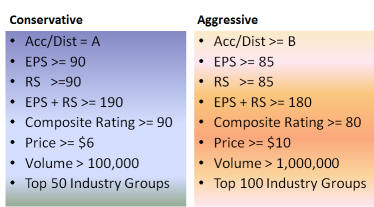 |
|||||||
|
|||||||
Strategic InvestingA Service of Adrich Corporation |
|||||||
| Strategic Investing focuses on stocks with increasing revenues and profits. KISS + SF! |
Frequently Asked QuestionsThe following questions are those most frequently asked by our new subscribers and the answers pertain to the Conservative portfolio but can be applied to the other Strategic Investing portfolios. 1. Should I buy every stock that appears on the Stock Watch List?No, No, No. Stocks that appear on the Strategic Investing Conservative Stock Watch List are there for you to consider as possible candidates. You should perform your own due diligence and decide if the company’s technical and fundamental factors meet your investing style. The stocks that make the Strategic Investing Stock Watch List are the results of our filters which put a high reliance upon the Investor’s Business Daily® or High Growth Stocks rating factors. Our filter looks at the EPS Rating, the RS Rating and the Accumulation/Distribution Rating (ACC/DIS RTG®). The basic filters for the Conservative and Aggressive portfolios using the IBD® rating factors are shown below:
You can screen for these rating factors directly from the tables in Investor's Business Daily® by inspection. However, it is quicker and easier to utilize the MarketSmith Screener or High Growth Stocks to perform these scans. 2. What is the definition of a winning stock?In Strategic Investing, a winning stock is defined as a stock that increases in value at least 50% from the time it is first placed on the Stock Watch List. 3. Do you have other factors that determine the suitability of a stock for purchase?Every investor has their own factors that influence the suitability of a stock as an addition to a portfolio. Our personal preferences include the following:
4. How do you set an Action Point?An action point is either a Stop Loss or Take Profit point for a stock position. We advocate setting the initial Action Point at 3% below the entry price. This is the point at which you should set an Alert or a Stop Loss order to prevent a price decline from impairing your capital position. Remember that a Stop Loss order becomes a market order upon implementation and the price you actually receive for your stock may be less than your Stop Loss point. Thereafter, the Action Point is set at 6% below the end of day closing price. Once, the 6% Action Point is higher than the initial Action Point calculated at 3%, we switch over to the 6% level. Assuming that you were correct in selecting a stock that is going up, we advocate that you adjust the Action Point either on a daily or weekly basis depending upon your investing style to lock in those hard-earned profits. For example, assume you purchased ABC stock at $10.00 per share. Your initial Action Point would be $9.70 per share. If the price went up to $12.00, your new Action Point would be $12.00 * .94 = $11.28. Action Points are never reduced for stocks in which you have a long position. At the time, you have a profit of 15% in the shares purchased, we then let our Action Point become when the 8 day simple moving average descends below the 20 day simple moving average. Reverse these rules if you are shorting a stock. 5. How do you decide how much to invest in a stock?There are many different theories on position sizing. Since we are mostly interested in performance rather than diversification, our recommendation is that your stock portfolio should have no more than 15 and preferably fewer stocks in it. We normally have less than 10 stocks in our portfolio at any one time. When we decide to invest in a stock (or conversely to short a stock), we take a position that is about 10% of our stock portfolio. For example, assume that your portfolio has a total stock value of $150,000. Based upon our Strategic Investing rules, we would buy a position in the new stock that was approximately $15,000. Of course, since we only buy in 100 share increments and do not use odd-lots, we purchase our positions to the nearest round lot. As a result, the amount could be less than or greater than $15,000. We have found that not having to worry about odd-lot holdings is better than the hassle of being exact. Over a long period of time, things even out. 6. How should I begin to follow your Stock Watch List?We suggest that you begin by looking at the stocks which just make the list each week and to perform your own due diligence upon them. Then, if you decide that the stock meets your criteria, you paper trade the stock. After a period of weeks and maybe months, you will begin to feel confident in the quality of your due diligence and your ability to read charts and to set Action Points either on a weekly or daily basis. Then, and only then, should you begin to risk your hard-earned dollars. 7. Why do some of the Stock Watch List selections immediately break down and activate the Stop Loss point?Over the years, we have found a number of our Stock Watch List selections that exhibit "exhaustion highs." These are stocks which by the time they reach the Strategic Investing filter requirements of A + 190 have already made their upward moves. In many cases, a careful review of the stock chart and the volume and other technical indicators will enable you to avoid taking a position in these stocks. However, in some cases, the exhaustion high will not be apparent and the Stop Loss point is necessary to protect your position. 8. What percentage of my trades will be losses?If you are disciplined and set Stop Losses either daily or weekly, our subscribers report that somewhere between 25 and 55% of their trades are small losses. However, they also report that their gains on their portfolio more than offset these losses. We believe that the due diligence process and your skill in reading charts can reduce this percentage. Since 1996, we have taken small losses in about 55% of our trades in the Conservative portfolio but our gains have more than offset these losses every year. Adrich
Corporation - Copyright 2001-2013 - All rights reserved. The William O’Neil + Co. 197 Industry Groups is a trademark of William O’Neil + Company, Inc. and is used by Investor’s Business Daily under license agreement. CAN SLIM and variations are marks of Investor's Business Daily, Inc. and affiliates ('IBD'). IBD does not license, review or approve of, and is not responsible or liable for any investment advice or other services provided by the user. The user is not an agent of, sponsored by, affiliated with, or owned by IBD and is not authorized by IBD to make any representations, warranties, or promises.
|
Last updated - February 6, 2007
